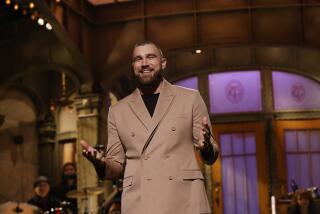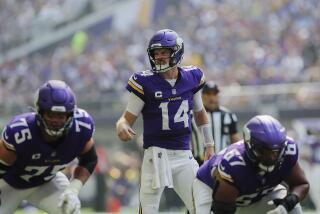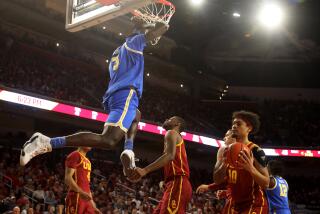Players Know Bubble May Burst at Any Time
WASHINGTON — “Am I supposed to read something into this?”
Jeff Rutledge had just poked his head out of the locker-room door at Redskin Park and realized, as did the dozen or so others nearby, that there was every reason to read something dreadful into the goings-on about 50 yards away. Three men were conspiring to make Rutledge an unemployed Redskin within a week.
Specifically, on the grass practice field, John Brandes was hiking a football to Kelly Goodburn, who was spotting it under the watchful eye of special-teams coach Wayne Sevier. The key to the exercise was Goodburn, the holder.
“That’s my job, so to speak, with Chip” Lohmiller, Rutledge said, referring to a hold-and-kick combination that last year was effective on 30 of 40 field goal tries during the regular season and three of three in the playoffs.
Rutledge could have reacted to the embarrassment in a number of ways. He could have pouted in public. He could have gone back inside and thrown equipment. His inclination was toward the gallows humor of a professional adept at survival.
“Hey, Wayne,” a smiling Rutledge yelled. “I’ll be right out. Soon as I change clothes.” Equally uncomfortable, Sevier acknowledged the bravado with a feeble wave.
Rutledge is one of at least 40 Redskins who are riding what is known in pro football as “the bubble.” (Yes, 40 of the 60 players are replaceable.) He’s riding it as a rodeo veteran would an ornery bull -- and he’s been doing it not for 12 seconds at a pop but almost continuously for 12 years.
“I’ve honestly never been in a training camp where I felt real confident I’d be there at the end,” he said. “I’ve learned to accept it, to adjust to it, to live with it. You do a lot of praying. If it works out, it works out.”
Looking at the postpractice cram course for Goodburn, the 34-year-old Rutledge said: “Probably, this is the worst that it’s been.”
There are only 47 jobs available to each NFL team. And all the teams, like the Redskins, are trying to squeeze the most out of each job. If a punter, such as Goodburn, can double as the holder for place kicks, so much the better. Except that it nullifies an advantage Rutledge holds at quarterback over Stan Humphries and Cary Conklin.
Most fans--and some players -- might be surprised at such a high figure for “the bubble.” At least 40? That’s two out of every three players currently on the roster. And only 13 cuts are necessary next week to reach the regular-season limit.
The grim news is that very few players on each NFL team cannot be replaced.
“As a rookie, I thought that once you broke camp the cuts were done,” said 12-year veteran linebacker Monte Coleman. “But after we got back here, before a practice, they cut a defensive lineman named Angelo Wells. That made me realize you have to be up on your game always.”
The more a man can do the better his chances of lasting in the NFL. Thus, Brandes, a tight end, has made a nice living for four years snapping the football toward a teammate on one knee.
Lots of times, the final judge on who makes the Redskins is Sevier.
Coleman recalled a play in a practice during his rookie season where his instincts and speed put him in a position to break coverage at the line of scrimmage and bat away a pass downfield.
“Jack Pardee was the coach at the time -- and he made a real big deal out of it. He mentioned that a couple of times. It also was important that I was being compared with Hollywood Henderson (of the Cowboys) on special teams. He was the first linebacker put out on release (to get downfield first) for punt coverage. He--and I--had the speed and size to beat blocks and get downfield in a hurry.”
To Redskins scouts, the smallish Darrell Green not only looked like a football player but also a first-round draftee.
“When do I think the coaches knew I could play?” said Green, repeating a question. “I think they knew when they drafted me. To say otherwise would be an insult to them and the scouting staff. They spend thousands of dollars, thousands of man hours, thousands of travel hours looking at people. Even though they miss sometimes, they’ve earned respect.”
Green excelled -- quickly -- at the hardest position to scout: cornerback.
“I had no reservations,” he said. “All I said was: ‘When do we start?’ Whether (holdout) Jeris White came back or not was of no concern to me.
“It’s hard to make a great corner. They’re born. If you play it the way I play it -- on the edge all the time -- you’re going to have a lot of setbacks. I’ve been beat -- and will be beat some more. But that’s not the issue. The issue is to play after you get beat. You can’t teach that.”
More to Read
Go beyond the scoreboard
Get the latest on L.A.'s teams in the daily Sports Report newsletter.
You may occasionally receive promotional content from the Los Angeles Times.










